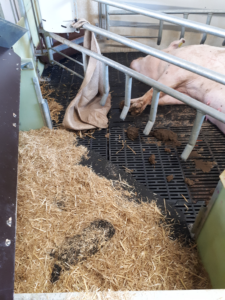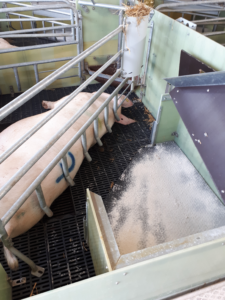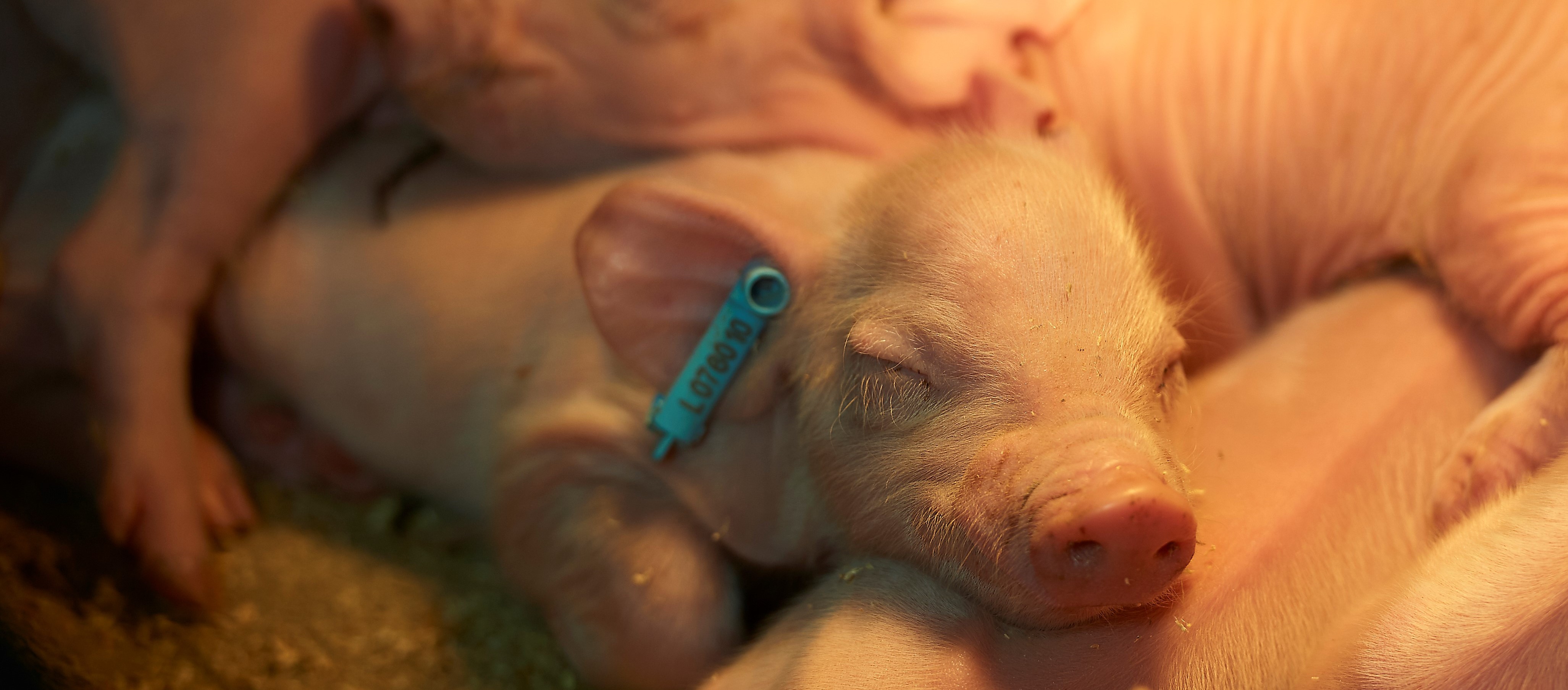Lisbeth Ulrich Hansen, Senior Research Scientist, Danish Pig Research Centre
Abstract
Significantly more piglets use the creep during specific resting periods on day 2 after farrowing if the creep is prepared with approx. 2 cm straw, a sock with wheat grains and a jute sack which the sow had used as nesting material compared the traditional creep training.
This trial included two groups (control and trial) with a total of 395 litters. In the control group, creep training was performed in connection with the two first feedings d 1 and 2 post-farrowing. In the trial group, a dedicated effort was made to attract the piglets into the creep.
Sows were loose until the day before expected farrowing when they were confined. The crate was opened 3-5 days post-farrowing. The farrowing pens had fully drained floor and the creep was equipped with a rubber mat and a heat lamp in the roof.
Creep training is a demanding task and may result in the piglets staying in the creep for such a long time that they miss 1-2 sucklings. Therefore, pig producers are recommended to make a dedicated effort to prepare the creep around the time of farrowing rather than creep training.
Background
A significant part of the liveborn piglets that die after birth in the farrowing pen, die before crossfostering [1]. The primary causes of death include crushing, starvation and hypothermia [2] [3] [4] [5]. Research has shown that the temperature in the pen immediately after birth is essential to restoration of the body temperature [16].
One way of reducing piglet mortality is to get the piglets into the creep quickly after birth. The sooner the piglets start using the creep, the sooner they will be out of the sow’s area where the risks of crushing or hypothermia are high. The creep will provide an optimum temperature for the piglets. In particular when sows are loose, piglets risk getting crushed and it is therefore highly desirable to teach them to use the creep as soon as possible.
Research has repeatedly demonstrated that piglets spend the most time by the sow’s udder the first two days post-farrowing compared with the remaining piglet period [6] [7] [15]. This was recently observed in a product test of ten different farrowing pens for loose sows [8]. In the majority of these pens, the creep was empty in 30-50% of the observations made twice daily in the period 0-6 days post-farrowing.
Two foreign studies investigated whether piglets faster learnt to use the creep if they were confined in the creep while the sow was eating. Berg et al. studied the effect of confining the piglets in the creep for 20 minutes during the two and four first feedings after farrowing, respectively. Results demonstrated a significant increase in piglets’ use of the creep the first three days; from 15% on day 1 to more than 50% on day 3 [9].
Andersen et al. also investigated the effect of no creep training vs confinement in the creep for 20 minutes during the sow’s first two or four feedings. Andersen et al. concluded that creep training did not affect mortality or piglets’ use of the creep [10].
Hrupka et al. investigated whether piglets are attracted by scent and contact with other piglets – either litter mates or piglets from other litters – and concluded that piglets are in fact attracted by other piglets, also if they come from other litters [11].
In the Netherlands, Hoofs studied jute sacks used as nesting material. Post-farrowing, the remains of the sack were placed in the creep, and Hoofs found that the piglets preferred the jute sacks, regardless of whether the sacks were placed in the creep or in the pen, and believes that this is attributed to the scent of the sow and the fact that pigs like to lie against something [12].
Welch & Baxter found that piglets preferred warm and soft surfaces to cold and hard surfaces [13]. The preference for a soft environment is supported by Ziron & Hoy (2002) who tested a so-called warm water bed with a temperature of 32.3°C. Results showed a greater use of this compared with a foam mat (27.9 °C), a heated board (33.9°C) and straw bedding (28.4°C). However, these observations were made in the period day 3-5 post-farrowing, and it is therefore unclear whether the warm water bed might have an impact on piglets’ creep behaviour in the period d 0-3 post-farrowing [14].
The above findings were included in the current trial where the aim was to determine if the piglets were more inclined to use the creeps during specific resting periods day 2 post-farrowing if the creep was fitted with a jute sack (scent of the sow, something to lie against), chopped straw (soft, warm) and a sock containing wheat grains (something to lie against). This was compared with traditional creep training where piglets were confined in the creep when the sow was feeding.
Materials and methods
This trial was performed on a farm with approx. 1,400 sows/year and farrowing pens for loose sows. Five sections were established with 78 farrowing pens each (2.4 m x 2.4 m). The pens were equipped with fully drained floor (plastic and cast iron), and creeps were fitted with a rubber mat and a heat lamp (150 W) (see figure 1).
Pen temperature and heat supply to the creep complied with the current recommendations from SEGES Danish Pig Research Centre. To ensure an optimum temperature in the creep areas, pens by the outer wall were not included in the trial. The heat lamps were turned on the day before expected farrowing.

Figure 1a. Farrowing pen included in the trial, with fully drained floor and a creep with a roof. The heat lamp was installed in the roof of creep.

Figure 1b. The sow was confined during farrowing. All sows were given straw as nesting material in a rack placed on one side of the crate.
The sows were loose from transfer to the farrowing pen and until the day before expected farrowing. The crate was opened the day after castration, corresponding to day 3-5 after farrowing. All sows were given straw as rooting/enrichment/nesting material supplied in a rack placed on one side of the crate (see figure 1).
The sows were fed liquid feed at 8:00, 13:30 and 19:30.
Trial design
The sows in both groups were of the same age. Only sows that had completed farrowing after the workday ended at 16:00 and before 7:00 the following morning were included in the trial. The trial ended at 14:30 day 2 post-farrowing.
Split-suckling was practised in both groups at the first feeding after farrowing: all piglets were confined in the creep before feeding; once the sow had eaten, the smallest piglets were given access to the udder for roughly 30 minutes before the rest of the litter was let out of the creep.
Crossfostering was performed during the day of farrowing: sows were given 15 piglets, the gilts were given 16 piglets. After crossfostering, litters were fixed.
The trial comprised the following groups:
Group 1: Control = Creep training in connection with first two feedings (figure 2 and 4):
- Just before the sows were fed at 8:00 and at 13:30, all piglets were confined in the creep
- Piglets were let out approx. 30 minutes later when the sow had eaten and was lying down
Group 2: Trial = Dedicated effort to make piglets use the creep (figure 3):
- Before transfer of the sow, a 2 cm layer of chopped straw was scattered on the creep floor and a sock containing wheat grains was placed in the middle of the creep.
- A jute sack was offered to the sow as nesting material
- Once farrowing was underway, the jute sack was placed in the front part of the creep
- Just before feeding at 8:00 and 13:30, two piglets were placed in the middle of the creep, up against the sock with wheat grains (if there were already piglets in the creep, no more piglets were moved to the creep). The two piglets closest to the pen gate were moved to the creep.

Figure 2. Example of creep layout in the control group.
 Figure 3. Example of creep layout in the trial group. Prior to transfer of the sow, straw and a sock containing wheat grains were placed in the creep. The jute sack was placed in the creep when farrowing started.
Figure 3. Example of creep layout in the trial group. Prior to transfer of the sow, straw and a sock containing wheat grains were placed in the creep. The jute sack was placed in the creep when farrowing started.
The number of piglets in the creep and in the remaining part of the pen, respectively, was recorded on day 2 at the following times of the day:
- At 7:00 before activity/staff started working in the section
- At 9:30 after the sow had eaten
- At 11:30 ”quiet” in the section, inbetween feedings
- At 13:00 just before feeding at 13:30
- At 14:30 ”quiet” in the section after feeding
If piglets were suckling during an observation, this was noted and the observation was excluded from the dataset.
Results
The trial comprised 395 sows/litters (198 in the control group and 197 in the trial group) corresponding to 1,951 piglets (978 in the control group and 973 in the trial group).
Both groups had averagely 14.5 piglets/litter day 2 after crossfostering.
Table 1 shows that a significantly higher (p=0.027) percentage of piglets used the creep in the trial group where straw, sock and jute sack were used (figure 5) compared with the control group where creep training was practised (figure 4).

Figure 4. In the control group, creep training was practised during feeding of the sow.

Figure 5. In the trial group, the creep was fitted with straw, a sock with wheat grains and a jute sack that the sow had used as nesting material.
Table 1. Piglets observed in the pen and creep, respectively, and percentage of pigs using the creep. Average of all observations. a and b are significantly different p=0.027.
Table 2 shows the percentage of piglets using the creep during the five observations. It is clear that at all times, the percentage of piglets in the creep was highest in the trial group where straw, a sock and a jute sack were used compared with the control group where creep training was practised.
Table 2. Percentage piglets that used the creep during each observation (estimated data).

Analysis of piglet mortality was not included in the trial design, but based on the number of dead piglets observed, there is no reason to assume a difference between the groups.
Conclusion
When the creep is fitted with roughly 2 cm straw and a sock containing wheat grains and when a jute sack used by the sow as nesting material is placed in the creep once farrowing has begun, significantly more piglets use the creep during specific resting times on day 2 after farrowing compared with creep training.
Consequently, the traditional creep training is not the way to make piglets use the creep faster after farrowing; making the creep attractive to the piglets is much more efficient.
Acknowledgements
The activity was funded by the Pig Levy Fund.
References
[1] Hales, J. Moustsen, VA., Nielsen, BF, Hansen, CF., 2015. Temporary confinement of loose-housed hyperprolific sows reduces piglet mortality. J. Anim. Sci. 93: 1–10.
[2] English, PR., Morrison, V., 1984. Causes and prevention of piglet mortality – Review article. Pig News and Inform. 5: 369-376.
[3] Dyck, GW., Swierstra EE. 1987. Causes of piglet death from birth to weaning. Can. J. Anim. Sci. 672: 543-547
[4] Andersen, I.L., Berg, S., Boe, K.E., 2005. Crushing of piglets by the mother sow (Susscrofa) – purely accidental or a poor mother? App. Ani. Behva. Sci. 93: 229-243.
[5] Marchant, JN., Broom, DM., Corning, S., 2001. The influence of sow behaviour on piglet mortality due to crushing in an open farrowing system. Anim. Sci. 72: 19-28.
[6] Houbak, B., Thodberg, K., Malkvist, J., and Pedersen LJ., 2006. Effect on pen floor heating on piglets use of heated area 0-120 h postpartum. Proc. 40th Int. Congress of the ISAE, 156.
[7] Pedersen, LJ., Jorgensen, E., Heiskanen, T., Damm, BI., 2006. Early piglet mortality in loose-housed sows related to sow and piglet behaviour and to the progress of parturition. App. Anim. Beh. Sci. 96: 215-232.
[8] Hansen, L.U., 2018. Produkttest af ti farestier til løsgående søer. SEGES Svineproduktion. Erfaring nr. 1803.
[9] Berg, S., Andersen, IL., Tajet, GM., Haukvik, IA. Kongsrud, S., Bøe, KE., 2006. Piglet use of the creep area and piglet mortality – effects of closing the piglets inside the creep area during feeding time in pens for individually loose-housed sows, Anim. Sci. 82: 277-281.
[10] Andersen, IL., Tajet, GM., Haukvik, IA., Kongsrud, S., Bøe, KE., 2007. Relationship between postnatal piglet mortality, environmental factors and management around farrowing in herds with loose-housed, lactating sows. ActaAgr. Scand. 57, 38-45.
[11] Hrupka, B.J.; V.D. Leibbrandt, T.D. Crenshaw and N.J. Benevenga, 2000. Effect of sensory stimui on huddling behavior of pigs. J. Anim. Sci. 78:3:592-596
[12] Hoofs, A. (2013). Jute stattPlastik, top agrar 2/2013.
[13] Welch, AR. Baxter, MR., 1986. Responses of newborn piglets to thermal and tactile properties of their environments. App. Eng. In Agri. 17: 515-519.
[14] Ziron, M., Hoy, S., 2002. Effect of a warm and flexible piglet nest heating system – the warm water bed – on piglet behaviour, live weight management and skin lesions. Appl. Anim. Behav. Sci. 80: 9-18.
[15] Moustsen, V.A.; L.J. Pedersen & T. Jensen. 2007. Afprøvning af stikoncepter til løse farende og diegivende søer. Videncenter for Svineproduktion. Meddelelse nr. 805.
[16] Kammersgaard, T.S. 2013. Thermoregulation and thermal needs of neonatal piglets. PhD Thesis. Department of Animal Science. Faculty of Science and Technology. Århus University.











